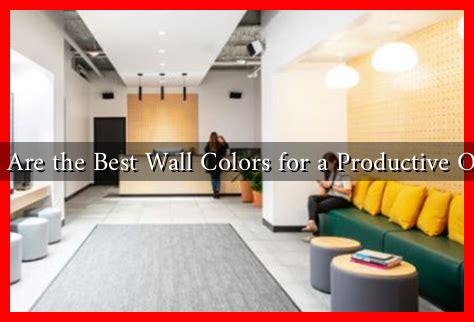-
Table of Contents
What Are the Best Wall Colors for a Productive Office?
Creating a productive office environment is essential for maximizing efficiency and fostering creativity. One of the most impactful yet often overlooked elements of office design is wall color. The colors we surround ourselves with can significantly influence our mood, energy levels, and overall productivity. In this article, we will explore the best wall colors for a productive office, backed by research and expert opinions.
The Psychology of Color in the Workplace
Color psychology is the study of how colors affect human behavior and emotions. Different colors can evoke various feelings and responses, making them powerful tools in office design. According to a study by the University of Texas, color can influence productivity by as much as 20%. Here are some key colors and their psychological effects:
- Blue: Often associated with calmness and stability, blue can enhance focus and concentration. It is an excellent choice for offices where deep thinking and concentration are required.
- Green: Symbolizing nature and tranquility, green is known to reduce stress and promote a sense of balance. It is ideal for creative spaces where innovation is encouraged.
- Yellow: A bright and cheerful color, yellow can stimulate creativity and optimism. However, too much yellow can lead to anxiety, so it’s best used as an accent color.
- Gray: A neutral color that conveys professionalism, gray can create a sophisticated atmosphere. However, it can also be dull if overused, so pairing it with brighter accents is advisable.
- Red: This bold color can increase energy and urgency, making it suitable for high-energy environments. However, it can also be overwhelming, so moderation is key.
Best Colors for Different Office Types
Choosing the right color also depends on the type of work being done. Here’s a breakdown of the best colors for various office environments:
- Creative Spaces: For design studios or brainstorming areas, consider using vibrant colors like orange or yellow to inspire creativity and collaboration.
- Corporate Offices: In more traditional settings, shades of blue or gray can create a professional atmosphere while promoting focus and productivity.
- Home Offices: For remote workers, a combination of green and blue can create a calming yet productive environment, helping to balance work and relaxation.
Case Studies and Real-World Examples
Several companies have successfully utilized color psychology in their office designs. For instance, Google’s offices are known for their vibrant colors, which foster creativity and collaboration among employees. A study conducted by the University of British Columbia found that employees in colorful environments reported higher levels of creativity and satisfaction.
Another example is the tech company Basecamp, which uses a palette of soft greens and blues in their office. This choice has been linked to increased focus and reduced stress levels among employees, leading to higher productivity.
Statistics on Color and Productivity
Research supports the idea that color can significantly impact productivity. According to a survey by the online design platform, Canva, 93% of people make judgments about a person or product based on color alone. Furthermore, a study by the Institute for Color Research found that color increases brand recognition by up to 80%, which can be crucial for businesses aiming to create a strong identity.
Conclusion: Choosing the Right Color for Your Office
In conclusion, the wall color of your office can play a crucial role in enhancing productivity and creating a positive work environment. By understanding the psychological effects of different colors and considering the nature of your work, you can make informed decisions that benefit both you and your team. Whether you opt for calming blues, invigorating yellows, or balanced greens, the right color can transform your workspace into a hub of creativity and efficiency.
Ultimately, the best approach is to experiment with different shades and combinations to find what resonates most with you and your team. Remember, a well-designed office is not just about aesthetics; it’s about creating an environment that fosters productivity and well-being.




